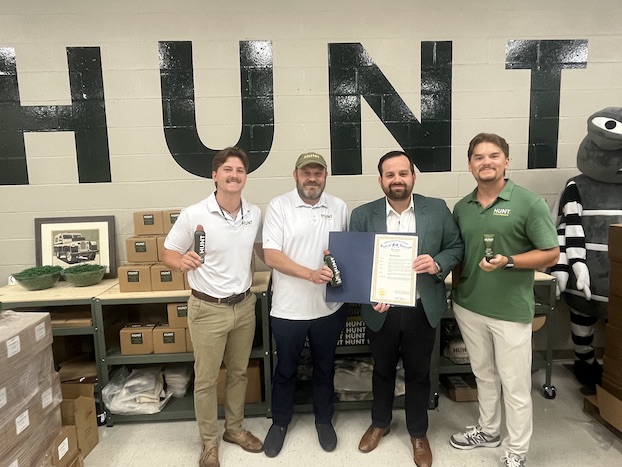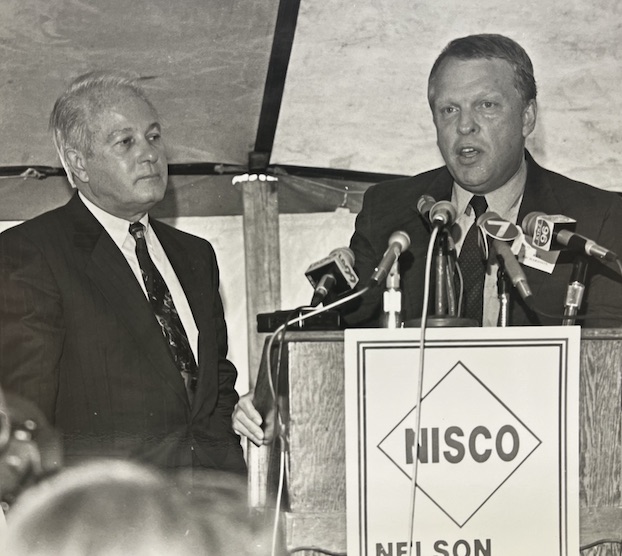One sister’s life-saving gift: ‘It was my honor. She’s my person,’ Babst says of donating a kidney
Published 7:26 am Friday, April 25, 2025

- Sisters Anne Griepsma, NP and Alice Babst, MD, have been working together in Obstetrics and Gynecology taking care of women for years. Their dedication to their patients and healthcare is matched only by their caring bond for each other. (Special to the American Press)
Looking at her now, one wouldn’t know Anne Griepsma has gone through multiple major surgeries, including a recent life-saving kidney transplant.
Griepsma says the selfless gift of organ donation by her sister, Dr. Alice Babst, is the reason she is thriving today.
“If I didn’t know all the things that have happened over the past couple of years, I would think we were just rolling with life,” Griepsma, a nurse practictioner, said. “I forgot that this is what life actually looks like.”
Trending
At 13, Griepsma was diagnosed with lupus — a chronic, autoimmune disease where the body’s immune system mistakenly attacks healthy tissues, causing inflammation and damage.
“As an eighth-grader I was dealing with lupus, the medication, and I went through a bunch of rounds of chemotherapy just trying to get it to go into remission,” Griepsma said.
Once a month, for six years, she would undergo the chemotherapy treatment.
“Sometimes I wondered if the doctors forgot I was on it,” she said with a laugh. “I know that’s not true, but it just seemed like forever.”
Ten years after her diagnoses, her lupus went into a remissive state — a period when the symptoms of the disease are reduced or disappear.
“This was a robbed childhood, very much so,” Babst, who’s older by just a year and a half, said. “She grew up very quickly and is downplaying this. There were several near-death hospitalizations. At one point she had a hypertensive crisis and had a brain bleed and was in the hospital in 10th grade and had to relearn how to walk and talk and write.”
Trending
Griepsma said when she went into remission — other than taking several doses of medication daily — life became “relatively normal.”
That lasted for about 20 years until she noticed periods of fatigue and joint pain near the end of 2022.
“I had two kids to worry about, a job and life and all that and I just thought if I don’t acknowledge it, it will go away,” Griepsma said. “I had been doing so well for so long.”
She said she began experiencing a chronic cough that December that she attributed to cold and flu season. The cough made her hoarse for about three months. She also began coughing up blood.
“Still, I didn’t go to the doctor,” Griepsma said. “I should have because when I started to think about it when all this was going on I did notice my urine output had become a little bit less. I wasn’t waking up at night to go to the bathroom like I used to and the volume wasn’t as much, but I wasn’t retaining fluid so I thought it was fine and I was just tired and didn’t feel good.”
By March 2023, she had dropped 10 pounds, her fitness monitor wasn’t picking up her heart rate when she was working out, she couldn’t lift heavy weights any longer, and the constant fatigue continued.
“I was falling asleep in my car, falling asleep at my desk, coming home from work and falling asleep on the couch,” she said. “I couldn’t stay awake yet couldn’t sleep at night.”
During a flight home from a party she attended in St. Louis, Mo., her world started turning black and she began having trouble breathing. Upon landing, her boyfriend took her to the emergency room.
“They drew my blood work and then wanted to redo it,” she said. “On further examination it was determined that I had kidney failure, heart failure and was severely anemic. The doctor told me the last time someone came in with a blood count that low they were not alive when they got there.”
Griepsma also had hemorrhaging in her lungs, COVID and pneumonia.
She said the heart failure was diagnosed as viral cardiomyopathy — a condition in which viral infections lead to heart muscle inflammation. She would spend the next week hospitalized and on dialysis. Upon her release, the plan was for her to continue dialysis on an outpatient basis. That lasted only three days.
“My hands and feet became purple and ice cold and I couldn’t find my pulses,” she said. “I did have some back pain and some pain in my left shoulder. I was also having trouble swallowing food.”
Her boyfriend brought her back to the hospital, where the doctor told her she was having a heart attack. Scans revealed she had 80 percent blockage and needed a stint in her left main artery. After the procedure, she was airlifted to a New Orleans hospital.
“I was in critical care for four or five days and I actually felt OK,” she said. “When I was brought to a regular room, I developed severe abdominal pain and I found out I had a perforated colon. Basically, every organ in my body was trying to ease out on me.”
Though she remained hospitalized for several weeks, she wasn’t a candidate for colon surgery because of all of her other ailments. Griepsma was eventually released to return to her Lake Charles home — but the reprieve lasted only a few days.
“The abdominal pain got worse and I wanted to go to the emergency room this time,” she said. “I ended up having some abscesses in my abdomen and behind my uterus. They had to go in and put in drains — and keep in mind I’m still going through dialysis at this time. I stayed in the hospital for maybe four days and then I went home for a couple of days again and I felt awful. The pain was awful and I remember telling my sister, ‘I’m pretty sure this is what dying feels like.’ ”
She couldn’t walk, she had dropped to 90 pounds and she couldn’t do any of her normal activities. This time the diagnosis was a pulmonary embolism.
“At this point the surgeon is saying it would be more risky to not take me to surgery than to take me to surgery,” she said. “They did a clean out. I still had the drains when I woke up and, unfortunately, I also woke up with a colostomy bag.”
The procedure left her depressed and with severe body issues for months as she began tackling out-patient physical therapy.
“I fell on the floor and I couldn’t get back up because I was so weak. It was that bad. The therapy lasted three months and it really did put me in a new mindset that I could get strength back. I told myself, ‘OK. I can do this.’ ”
The added strength made her a candidate for surgery. In December of 2023, she had a foot of her colon removed. Two months later, the colostomy bag was removed. Seven months after that, it was transplant time.
“There’s a little more to that story, though,” Babst said. “You go through a lot of tests to be able to do the transplant. We started out with her being evaluated to see if she was a candidate. At first, they said maybe. When they saw her in person, that changed. After physical therapy, she was going to Orange Theory with a colostomy bag and going to dialysis three days a week and seeing patients as a single mother. She was still doing all the things. As soon as she could go back to the gym, she was doing that and she was trying out Pilates and going for walks. On the days she wasn’t wiped out from dialysis she was like, ‘I have to get my strength back,’ and her heart recovered. The heart function went from being in heart failure to going back to normal. When they saw her in person, they were like, ‘Woah, you don’t match your chart.’ ”
There are six sisters in their family. Doctors decided to test three initially to see if any would be a match.
Babst said there are six alleles — or genes — that doctors tested.
“I matched all six of her alleles, another sister matched four and another was two out of six,” Babst said. “We went with the perfect match because that’s the least chance of rejection.”
“With her being a six out of six match, they said it was like a twin,” Griepsma added.
Babst said doctors told the pair that Griepsma would be put to sleep first because they didn’t know what they would find when they opened her up. If the transplant couldn’t be done, Griepsma would have to remain on dialysis the rest of her life. If the transplant was possible, then Babst would be taken back to surgery and the process completed.
“It was really awful for her, going to sleep not knowing what was going to happen,” Babst said. “It was an awesome moment for me, though, when the surgeon came back and said, ‘Hey, we’re going.’ ”
Babst said she never hesitated in giving a part of herself to her sister.
“I was elated,” she said. “It was my honor. She’s my person. We’re best friends.”
The news left Griepsma, however, racked with guilt.
“I would call her every day and ask, ‘Are you sure you want to do this? What if it doesn’t work and you wasted a kidney? What if you die?’ It was very stressful,” Griepsma said.
“We’ve been best friends forever so it wasn’t even a question for me,” Babst said. “And I guess as a surgeon I wasn’t afraid.”
Griepsma said she remembers waking up from the surgery asking, ‘Did it happen? Did it happen?’ ”
Seven months post-surgery, Griepsma feels great. Her cardiovascular issues have reversed themselves and she’s been released from the care of her pulmonologist because her lungs have healed.
“It was such a huge gift and sacrifice on her part and that’s not something you can ever repay someone for,” Griepsma said of her sister’s selfless act.
April is Donate Life Month, and the sisters said they want to spend it spreading awareness on the process to become a living donor. There are more than 100,000 people waiting for a life-saving organ transplant and one person can save up to nine lives.
Griepsma said living donation offers several benefits, including shorter wait times and a higher chance of a successful transplant.
“Receiving an organ from a living donor, there is less chance of rejection,” Griepsma said. “Living organ donation is not something people talk about every day. Even just a piece of your liver can save somebody’s life.”
To become an organ donor, sign up for the state’s donor registry, mark the choice on your driver’s license when you get or renew it, and make sure your family knows you want to be a donor.





